The Best Fluffy Pancakes recipe you will fall in love with. Full of tips and tricks to help you make the best pancakes.
Graphic design stands as the cornerstone of visual communication merging art and technology to convey messages effectively. This creative discipline focuses on organizing typography logos and illustrations in traditional print media to create compelling visual compositions that capture attention and communicate ideas.
In the world of print media graphic designers carefully orchestrate every element to achieve harmony balance and visual impact. They follow established principles of design while incorporating their artistic vision to craft layouts that guide the viewer’s eye through the content. From magazine spreads to corporate brochures these professionals transform blank spaces into powerful visual stories that resonate with audiences and achieve specific communication goals.
Understanding Graphic Design in Print Media
Graphic design in print media combines typography, imagery, color theory, and spatial organization to create visual communication materials. Print designers organize elements on physical surfaces like paper, cardboard, or fabric to produce marketing collateral, publications, and advertising materials.
Key Elements of Print Design
- Typography Management: Arranges fonts, letter spacing, line heights, and text hierarchies
- Color Systems: Implements CMYK color models specific to print production
- Layout Grids: Creates structural frameworks for organizing content systematically
- Image Placement: Positions photographs, illustrations, and graphics strategically
- White Space: Utilizes negative space to enhance readability and visual impact
Print Design Applications
| Application Type | Common Examples | Primary Purpose |
|---|---|---|
| Marketing Materials | Brochures, Flyers, Posters | Promotional |
| Corporate Documents | Business Cards, Letterheads | Brand Identity |
| Publications | Magazines, Books, Newspapers | Information Distribution |
| Packaging | Product Boxes, Labels, Tags | Product Presentation |
Technical Considerations
- Resolution Requirements: Uses 300 DPI for sharp print reproduction
- Bleed Settings: Extends designs 0.125 inches beyond trim edges
- Paper Selection: Matches stock weight and finish to project needs
- Color Separation: Prepares artwork for four-color printing process
- Production Methods: Aligns design with offset, digital, or specialty printing
- Adobe InDesign: Creates multi-page documents and layouts
- Adobe Illustrator: Develops vector graphics and logos
- Adobe Photoshop: Edits and prepares photographic elements
- QuarkXPress: Produces professional publishing layouts
- Affinity Publisher: Offers alternative desktop publishing tools
The Core Elements of Traditional Print Layout

Print layout design integrates three fundamental components to create visually compelling compositions. These elements form the foundation of effective print media design across formats like magazines brochures posters.
Typography and Font Selection
Typography selection impacts content readability hierarchy composition in print layouts. Professional designers incorporate font families with distinct characteristics:
- Display fonts for headlines titles (Helvetica Futura Garamond)
- Body text fonts for optimal reading experience (Times New Roman Calibri Minion Pro)
- Supporting fonts for captions subheadings (Roboto Open Sans Proxima Nova)
- Font sizing ratios from 10pt body text to 48pt headlines
- Letter spacing adjustments between -20 to +100 units
Logo Design and Placement
Logo positioning follows established layout principles to maintain brand consistency visibility. Key placement considerations include:
- Upper left corner for primary brand recognition
- Centered alignment for symmetrical balance
- Lower right corner for secondary brand elements
- Clear space requirements (minimum 2x logo height)
- Size relationships (logo occupies 10-15% of layout area)
- Resolution requirements (300 DPI for photos 600 DPI for line art)
- Image formats (TIFF JPEG EPS)
- Color modes (CMYK for print RGB for digital)
- Bleed specifications (0.125 inches minimum)
- Scaling ratios (maintain aspect ratios avoid pixelation)
| Print Element | Specification | Standard Range |
|---|---|---|
| Body Text | Font Size | 10-12pt |
| Headlines | Font Size | 24-48pt |
| Logo Area | Space Ratio | 10-15% |
| Photo Resolution | DPI | 300+ |
| Bleed Area | Inches | 0.125-0.25 |
Print Layout Design Principles
Print layout design principles establish the foundation for creating visually appealing and functional print materials. These principles guide designers in organizing elements effectively across print media formats.
Balance and Visual Hierarchy
Visual hierarchy creates focal points through size contrast weight distribution across layouts. Strategic placement of design elements guides readers’ attention through:
- Size variations: Larger elements attract immediate attention while smaller elements provide supporting details
- Color contrast: Bold colors draw focus against neutral backgrounds
- Weight distribution: Heavy elements balance with lighter components
- White space: Strategic gaps between elements create breathing room
- Typographic hierarchy: Headlines stand out from body text through size font weight variations
Grid Systems and Alignment
Grid systems provide structural frameworks that organize content systematically across layouts. Key grid applications include:
- Column grids: Divide pages into vertical sections for text placement
- Modular grids: Create consistent spacing between design elements
- Baseline grids: Align text to maintain consistent vertical rhythm
- Margins: Set uniform spacing around page edges
- Gutters: Define consistent spacing between columns
- Reference points: Establish alignment markers for logos images text blocks
| Grid Type | Common Uses | Typical Measurements |
|---|---|---|
| Column Grid | Magazines newspapers | 3-12 columns |
| Modular Grid | Brochures catalogs | 8×10 modules |
| Baseline Grid | Books journals | 12-14 pt leading |
The systematic application of these principles creates professional layouts that enhance readability and visual appeal across print materials.
The Technical Side of Print Layout
Print layout design involves precise technical specifications and production requirements that ensure successful reproduction of designs in physical form. The technical aspects encompass resolution standards, color management systems, and pre-press preparation protocols.
Print Production Requirements
Print production demands specific technical parameters for optimal reproduction quality:
Resolution Standards:
- Images: 300 DPI for photos and detailed graphics
- Line Art: 600-1200 DPI for sharp edges
- Text: 1200 DPI minimum for crisp legibility
File Specifications:
| Element | Requirement |
|---|---|
| Bleed | 0.125″ – 0.25″ |
| Safe Zone | 0.25″ from trim |
| File Format | PDF/X-1a or PDF/X-4 |
| Image Mode | CMYK |
Color Theory in Print Design
Print color management utilizes specific systems and processes for accurate reproduction:
Color Models:
- CMYK process colors for standard printing
- PMS (Pantone Matching System) for spot colors
- Rich Black: C:60 M:40 Y:40 K:100
| Print Type | Color Space |
|---|---|
| Digital | CMYK |
| Offset | CMYK + Spot |
| Screen | RGB converted to CMYK |
- Total ink coverage limit: 280-300%
- Dot gain compensation: 15-20%
- Color trapping: 0.125-0.25 pt
- UCR/GCR settings for ink optimization
Evolution of Print Layout Design
Print layout design transformed from manual typesetting to digital composition through significant technological advancements spanning five centuries. The evolution reflects changes in both technical capabilities and aesthetic preferences in visual communication.
Historical Development
Print layout emerged in 1440 with Gutenberg’s movable type printing press, introducing standardized typography and consistent layouts. The Arts and Crafts movement of the 1880s elevated print design through ornate typography and decorative borders, while the Bauhaus school in the 1920s established minimalist principles and grid-based layouts. Key developments include:
- Metal typesetting (1884): Introduction of the Linotype machine enabling faster composition
- Photo typesetting (1949): Implementation of photographic techniques for text composition
- Desktop publishing (1985): Launch of PageMaker software revolutionizing digital layouts
- PostScript technology (1984): Creation of scalable fonts and vector graphics
- PDF format (1993): Standardization of digital file sharing and printing
- Responsive design systems adapting layouts across print and digital platforms
- Advanced typography management through OpenType features
- Variable data printing enabling personalized content in mass production
- Hybrid workflows integrating analog and digital techniques
- Cloud-based collaboration tools for remote design teams
- Automated layout systems using artificial intelligence
- Cross-media publishing platforms maintaining brand consistency
- Sustainable printing practices incorporating eco-friendly materials
| Era | Key Technology | Impact on Layout Design |
|---|---|---|
| 1440s | Movable Type | Standardized typography |
| 1880s | Steam Printing | Mass production capability |
| 1980s | Desktop Publishing | Digital composition |
| 2000s | Digital Printing | Variable data layouts |
| 2020s | AI Integration | Automated design systems |
Conclusion
Graphic design in print media stands as an essential discipline that transforms visual elements into powerful communication tools. Through careful organization of type logos and illustrations designers craft compelling layouts that engage audiences and convey messages effectively. Today’s print design combines time-tested principles with modern digital tools creating materials that meet both aesthetic and technical demands.
The field continues to evolve integrating new technologies while maintaining its fundamental role in visual communication. As print media adapts to changing times the art of organizing visual elements remains crucial for creating impactful designs that resonate with viewers and achieve communication goals.

